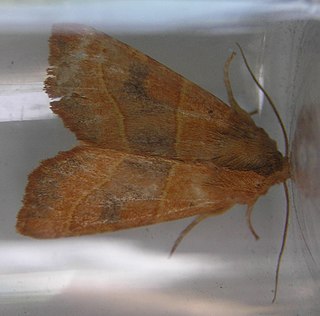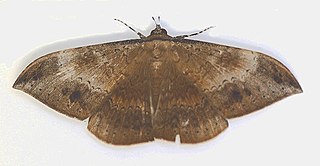
Xestia is a genus of noctuid moths. They are the type genus of the tribe Xestiini in subfamily Noctuinae, though some authors merge this tribe with the Noctuini. Species in this genus are commonly known as "clays", "darts" or "rustics", but such names are commonplace among Noctuidae. Xestia moths have a wide distribution, though they most prominently occur in the Holarctic.

Cycnia is a genus of tiger moths in the family Erebidae. The genus was erected by Jacob Hübner in 1818.

Antitype is a genus of moths of the family Noctuidae. The genus was erected by Jacob Hübner in 1821.

Atethmia is a genus of moths of the family Noctuidae. The genus was erected by Jacob Hübner in 1821.
Atypha is a monotypic moth genus of the family Noctuidae erected by Jacob Hübner in 1821. Its only species, Atypha pulmonaris, was first described by Eugenius Johann Christoph Esper in 1790. It is found in southern and central Europe, northern Turkey, Transcaucasia and the Caucasus.

Cerma is a genus of moths of the family Noctuidae. The genus was erected by Jacob Hübner in 1818.

Cryphia is a genus of moths of the family Noctuidae. The genus was erected by Jacob Hübner in 1818.

Diphtherinae is a monotypic subfamily of moths in the family Nolidae erected by Michael Fibiger and J. Donald Lafontaine in 2005. Its only genus, Diphthera, was erected by Jacob Hübner in 1809. The genus was moved from Noctuidae in 2013 after the phylogenetic analysis of Reza Zahiri et al. (2013).

Drasteria is a genus of moths in the family Erebidae.

Hemeroblemma is a genus of moths in the family Erebidae. The genus was erected by Jacob Hübner in 1818.

Lithophane is a genus of moths of the family Noctuidae. They spend the winter as adults. Some species are capable of feeding on other caterpillars or on sawfly larvae, which is rather uncommon among Lepidoptera.

Lygephila is a genus of moths in the family Erebidae. The genus was erected by Gustaf Johan Billberg in 1820.

Mocis is a genus of moths in the family Erebidae. The genus was erected by Jacob Hübner in 1823.

Omphalophana is a genus of moths of the family Noctuidae.

Polygrammate is a monotypic moth genus of the family Noctuidae. Its only species, Polygrammate hebraeicum, the Hebrew moth or Hebrew, is found in the eastern parts of North America, from Ontario, south to Florida and as far west as Texas. Both the genus and the species were first described by Jacob Hübner in 1818.

Schrankia is a genus of moths of the family Erebidae. It was described by Jacob Hübner in 1825.

Raphia frater, the brother moth or simply the brother, is a moth of the family Noctuidae. It is found from Nova Scotia west, across the forested regions of Canada to British Columbia, south to Mississippi in the east. The southern limits in the west are uncertain due to confusion with several closely related species or forms.

Euparthenos is a monotypic moth genus in the family Erebidae erected by Augustus Radcliffe Grote in 1876. Its only species, Euparthenos nubilis, the locust underwing, was first described by Jacob Hübner in 1823. The adults resemble some of the underwing moths of genus Catocala, which are fairly close relatives, in color, pattern, and the habit of resting on tree trunks. But E. nubilis can usually be immediately recognized by the four concentric black bands per hindwing, as opposed to one or two in Catocala. Color morphs of E. nubilis with altered pattern are known, however, and these may be hard to recognize without detailed examination.

Heliothinae is a small, cosmopolitan subfamily of moths in the family Noctuidae, with about 400 described species worldwide. It includes a number of economically significant agricultural pest species, such as Helicoverpa armigera and Helicoverpa zea.


















